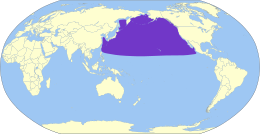Short-tailed albatross
| Short-tailed albatross | |
|---|---|

| |
| Scientific classification | |
| Domain: | Eukaryota |
| Kingdom: | Animalia |
| Phylum: | Chordata |
| Class: | Aves |
| Order: | Procellariiformes |
| Family: | Diomedeidae |
| Genus: | Phoebastria |
| Species: | P. albatrus
|
| Binomial name | |
| Phoebastria albatrus | |

| |
| Synonyms | |
|
Diomedea albatrus[4] | |
The short-tailed albatross or Steller's albatross (Phoebastria albatrus) is a large seabird from the North Pacific. With a wingspan of up to 2 metres (6 ft 7 in), it is the largest of the Albatrosses of the northern hemisphere. While breeding occurs in large colonies, the adult birds prefer a solitary life. It is a good flyer. 1949, almost all birds were thought to be extinct. When a few were re-discovered in 1951, they were protected. Since then, their numbers have increased, so that in 2022, they are no longer seen as "endangered", but as "vulnerable". Short-tailed albatrosses feed on cephalopods, fish, and crustaceans. They are oportunists, and will also feed on the organic waste ships throw overboard.
Although related to the other North Pacific albatrosses, it also exhibits behavioural and morphological links to the albatrosses of the Southern Ocean. It was described by the German naturalist Peter Simon Pallas from skins collected by Georg Wilhelm Steller (after whom its other common name is derived). Once common, it was brought to the edge of extinction by the trade in feathers, but with protection efforts underway since the 1950s, the species is in the process of recovering with an increasing population trend. Its breeding range, however, remains small.It is a part of the albatross family.
References[change | change source]
- ↑ BirdLife International (2018). "Phoebastria albatrus". IUCN Red List of Threatened Species. 2018: e.T22698335A132642113. doi:10.2305/IUCN.UK.2018-2.RLTS.T22698335A132642113.en. Retrieved 11 November 2021.
- ↑ "Appendices | CITES". cites.org. Retrieved 2022-01-14.
- ↑ Brands, S. (2008)
- ↑ American Ornithologists' Union

